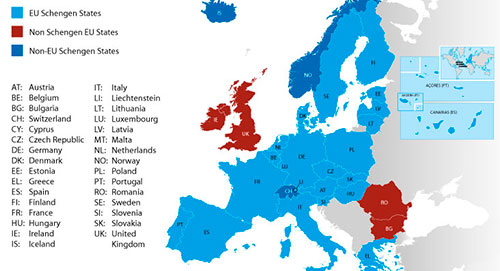It is an agreement that several European countries have abolished checks at internal borders (between those countries) and have moved these controls at the external borders (with third countries) .The agreement, signed in the Luxembourg town of Schengen in 1985 and in force since 1995, it establishes a common space -called Schengen space through which you can freely any person who has regularly entered at an external frontier or resident in one of the countries applying the Convention.

In total, the countries that are part of the Schengen area are 26:
- Germany
- Austria
- Belgium
- Denmark
- Slovakia
- Slovenia
- Spain
- Estonia
- Finland
- France
- Greece
- Hungay
- Iceland
- Italy
- Latvia
- Liechtenstein
- Lithuania
- Luxemboyg
- Malta
- Norway
- Netherlands
- Poland
- Portugal
- Czech Republic
- Sweeden
- Switzerland
The latter voted on February 9, 2014 by referendum, to restrict access of the citizens of Europe to their territory, which can lead to leave the Schengen area.
There are countries that belong to the Schengen agreement but have exceptions in the application of some points of the agreement and do not belong to the Schengen area. For example, the United Kingdom and Ireland are not part of the Schengen area but participate in police and judicial cooperation and the fight against narcotics.
Others like Bulgaria, Romania and Cyprus do not yet belong to the Schengen area because they do not meet the safety requirements, although other parts of the agreement apply. Iceland, Liechtenstein, Norway and Switzerland, which are not EU members, reached an agreement to join the Schengen area although Switzerland has voted in referendum abandon. Croatia, last country to join the EU, wants to join the agreement in 2015.
The aim of the Schengen agreement is the creation of an area of free movement, with the removal of common borders of the signatory countries. Through this agreement, the United abolished controls on common borders, strengthening its external borders, in order to impede illegal immigration of nationals of non-members of the European Union.
Thus, anyone with valid visa in the Schengen zone can move freely without performing border procedures at internal borders.
For the purposes of interpretation of the Agreement, should take into account these terms:
- Internal borders: it is the common land borders of the contracting parties. Also the airports for internal flights, and ports in terms of regular links between these countries.
- External borders: they are land borders, sea and airports, provided they are not internal borders.
- Domestic flight: flight with origin or destination in the territories of the contracting parties.
- Third State means a State that is not party.
- Abroad: any person who is not a national of the Member States of the European Communities.
- Border crossing any crossing point authorized by the competent authorities for crossing external borders.
You can see full information in:

